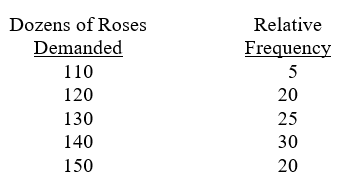Essay
The Rose Warehouse buys roses each week from Panama.A toll?free long distance call is made on Saturday night, and early Monday morning roses arrive at the airport in a box refrigerated with dry ice.The roses cost $8 a dozen and are sold on a cash-and-carry basis for $28 a dozen.Roses left over at the end of the week are put in a trash collector in an alley behind the store.Past sales (rounded to the nearest ten dozen) are as follows:
 The owner of the Rose Warehouse wants to compare two ordering rules for ordering roses: (1) order last week's demand plus 10 dozen extra (as safety stock), (2) order 130 dozen every week.He wants to run an eight-week simulation to compare the average weekly profit for the two rules.Last week's demand was for 110 dozen.He generated the following random numbers for weeks 1-8, respectively: 63, 13, 67, 50, 71, 25, 44, and 00.
The owner of the Rose Warehouse wants to compare two ordering rules for ordering roses: (1) order last week's demand plus 10 dozen extra (as safety stock), (2) order 130 dozen every week.He wants to run an eight-week simulation to compare the average weekly profit for the two rules.Last week's demand was for 110 dozen.He generated the following random numbers for weeks 1-8, respectively: 63, 13, 67, 50, 71, 25, 44, and 00.
a.What is the random number range corresponding to 130 dozen roses demanded?
b.Using ordering rule 1, what is the profit for week 3?
c.Using ordering rule 2, what is the profit for week 6?
d.What is the average profit over all eight weeks for ordering rule 1?
Correct Answer:

Verified
Correct Answer:
Verified
Q3: All of the following are verification techniques
Q4: _ trace the detailed logic or actions
Q6: All of the following are disadvantages of
Q7: If variability of demand were the only
Q8: Face validity involves asking people familiar with
Q9: Explain the major differences between a fixed-time
Q10: There is no single test to prove
Q11: Simulation language ProcessModel contains all of the
Q14: Define simulation and give some operations management
Q32: Spreadsheets are extremely strong in their ability